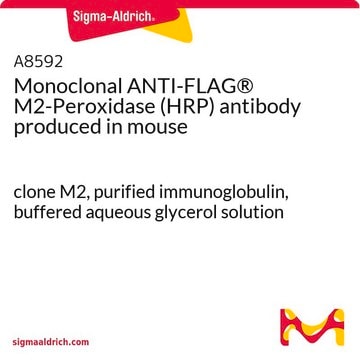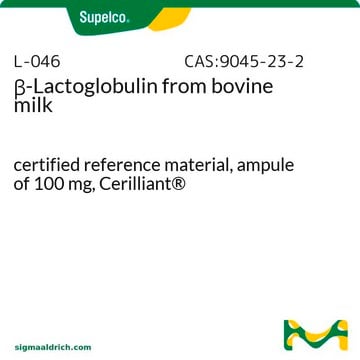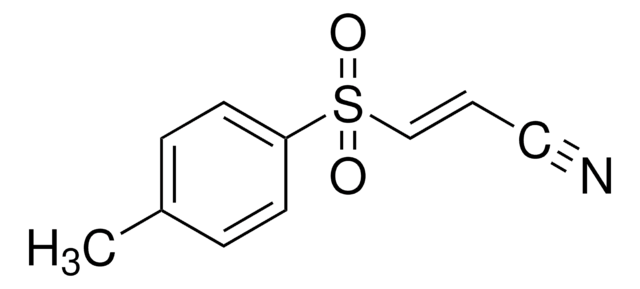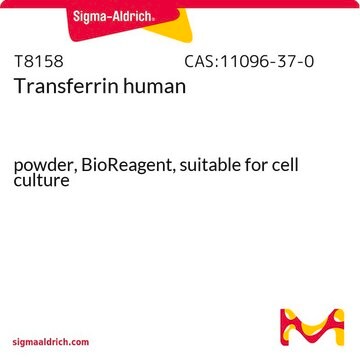The specification sheets for products SRP and L4894 do not mention testing for iron. The product SRP6519 undergoes basic testing, including appearance and SDS Page electrophoresis. On the other hand, product L4894 undergoes more detailed testing, including appearance, solubility, protein by biuret, SDS Page electrophoresis, as well as additional testing for infectious agents and use in cell culture. While iron is expected to be present, there are no confirmatory tests performed to document the amount of iron on a batch-to-batch basis.
L4894
Lactoferrin from human milk
powder, BioReagent, suitable for cell culture
Seleccione un Tamaño
185,00 €
Seleccione un Tamaño
About This Item
185,00 €
Productos recomendados
Línea del producto
BioReagent
Nivel de calidad
Ensayo
≥85% (SDS-PAGE)
Formulario
powder
mol peso
82.4 kDa
técnicas
cell culture | mammalian: suitable
color
white to light red
solubilidad
PBS, pH 7.4: 1 mg/mL, clear to slightly hazy (0.01 M phosphate buffer, 0.0027 M potassium chloride and 0.137 M sodium chloride, pH 7.4, at 25 °C)
Nº de acceso UniProt
Condiciones de envío
ambient
temp. de almacenamiento
2-8°C
cadena SMILES
N([C@@H](C(C)C)C(=O)N[C@@H](C)C(=O)N[C@@H](Cc1ccccc1)C(=O)N[C@@H](C(C)C)C(=O)O)C(=O)[C@@H](NC(=O)CNC(=O)[C@@H](NC(=O)[C@@H](N)CC(=O)N)C)CC(=O)O
InChI
1S/C35H53N9O12/c1-16(2)27(43-33(53)23(14-26(47)48)41-25(46)15-38-29(49)18(5)39-31(51)21(36)13-24(37)45)34(54)40-19(6)30(50)42-22(12-20-10-8-7-9-11-20)32(52)44-28(17(3)4)35(55)56/h7-11,16-19,21-23,27-28H,12-15,36H2,1-6H3,(H2,37,45)(H,38,49)(H,39,51)(H,40,54)(H,41,46)(H,42,50)(H,43,53)(H,44,52)(H,47,48)(H,55,56)/t18-,19-,21-,22-,23-,27-,28-/m0/s1
Clave InChI
QCBUWCQOKPLTDZ-PKRULZLPSA-N
Información sobre el gen
human ... LTF(4057)
¿Está buscando productos similares? Visita Guía de comparación de productos
Descripción general
Aplicación
- to test its neuroprotective effect on neuroblastoma cells and mouse mesencephalic dopaminergic cell lines MN9D [3]
- to test its antioxidative effect in Edible Bird′s Nest (EBN) induced toxicity in human neuroblastoma SH-SY5Y cells using oxygen radical absorbance capacity (ORAC) assay and 3-(4,5-dimethylthiazol-2-yl)-2,5-diphenyltetrazolium bromide (MTT) assay[4]
- in the preparation of immobilized titanium substrate for testingMG-63 osteoblast activity[5]
- as a low-density lipoprotein (LDL) receptor-related protein (LRP1) ligand in vascular smooth muscle cells (VSMC)[6]
Acciones bioquímicas o fisiológicas
Código de clase de almacenamiento
11 - Combustible Solids
Clase de riesgo para el agua (WGK)
WGK 3
Punto de inflamabilidad (°F)
Not applicable
Punto de inflamabilidad (°C)
Not applicable
Elija entre una de las versiones más recientes:
Certificados de análisis (COA)
¿No ve la versión correcta?
Si necesita una versión concreta, puede buscar un certificado específico por el número de lote.
¿Ya tiene este producto?
Encuentre la documentación para los productos que ha comprado recientemente en la Biblioteca de documentos.
Los clientes también vieron
-
Could you confirm whether products SRP6519 and L4894 Lactoferrin derived from human milk have confirmed iron content?
1 respuesta-
¿Le ha resultado útil?
-
Filtros activos
Nuestro equipo de científicos tiene experiencia en todas las áreas de investigación: Ciencias de la vida, Ciencia de los materiales, Síntesis química, Cromatografía, Analítica y muchas otras.
Póngase en contacto con el Servicio técnico













